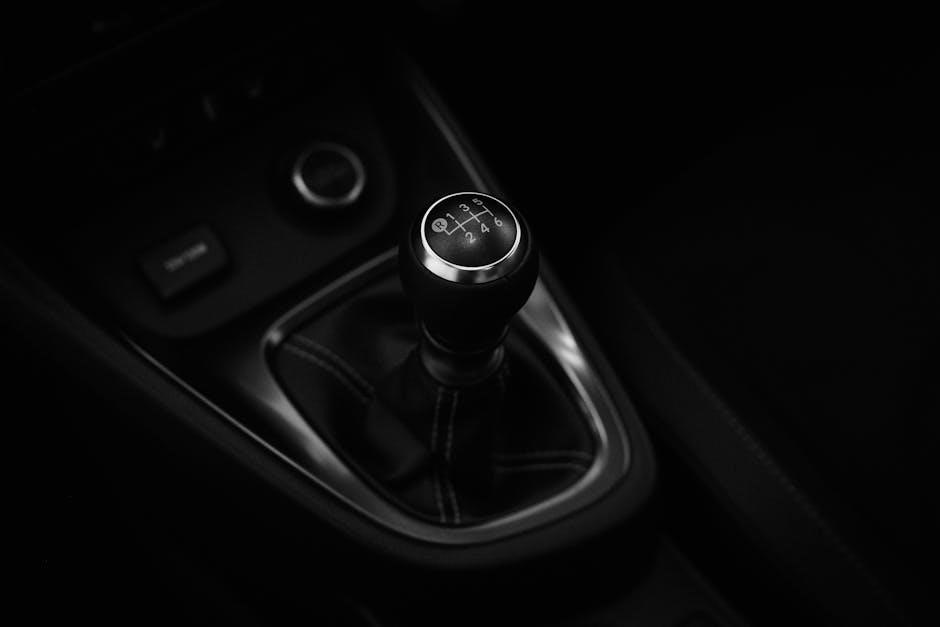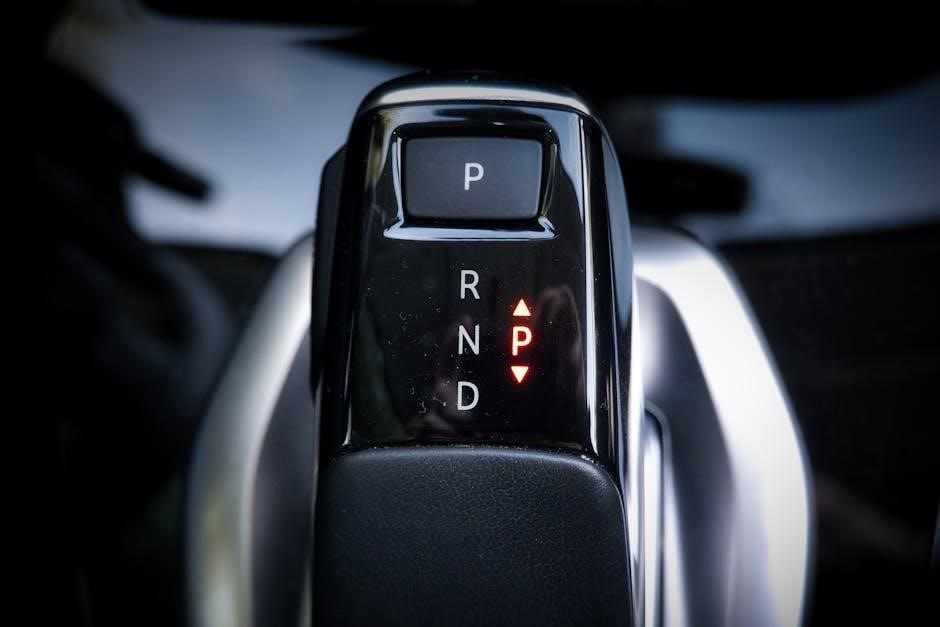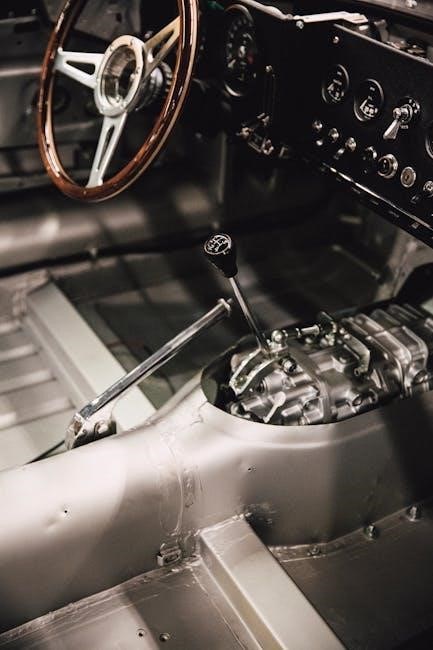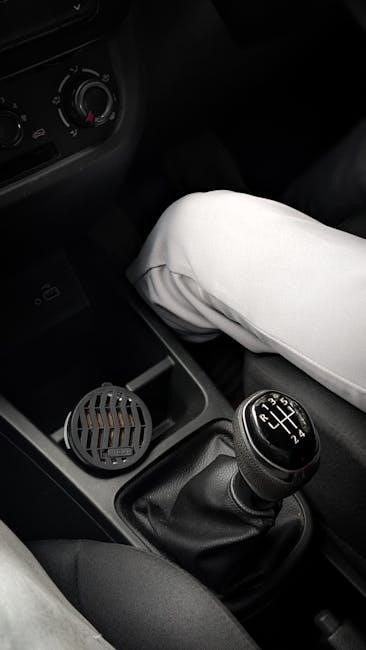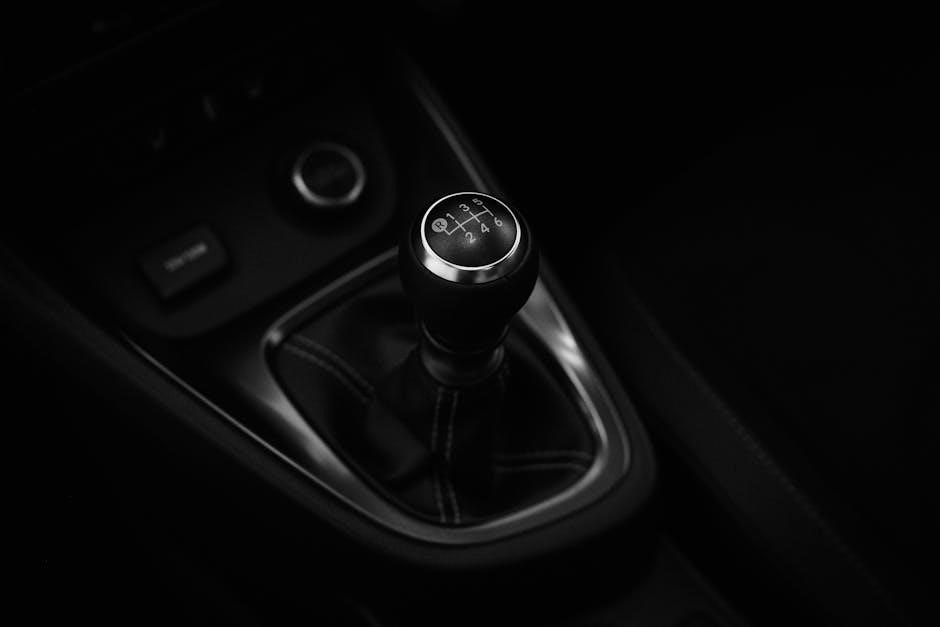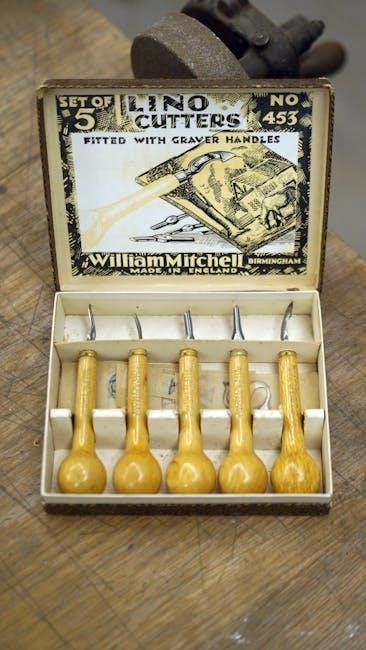clutch diagram for a manual transmission
A manual transmission and clutch system enable drivers to control gear shifts, essential for precise vehicle operation. The clutch connects and disconnects the engine from the transmission, allowing smooth gear transitions. Understanding the clutch diagram helps visualize components like the flywheel, pressure plate, and clutch plate, simplifying maintenance and repair processes.
1.1 Overview of Manual Transmission
A manual transmission, or stick shift, allows drivers to manually change gears using a clutch pedal and gear shifter. It provides precise control over power delivery, enabling efficient acceleration and smooth transitions between speeds. The system mechanically connects the engine to the transmission, requiring driver input to engage or disengage gears, ensuring optimal performance and fuel efficiency in various driving conditions.
1.2 Importance of the Clutch in Manual Transmission
The clutch is essential for smooth gear transitions in manual transmissions. It temporarily disconnects the engine from the transmission, allowing precise control over acceleration and deceleration. This prevents wear on transmission components and enables efficient power delivery, especially in demanding driving conditions like hills or towing, making it crucial for optimal vehicle performance and longevity.
Components of the Clutch System
The clutch system comprises key components like the flywheel, clutch plate, pressure plate, and clutch pedal. These parts work together to engage and disengage engine power smoothly.
2.1 Flywheel
The flywheel is a crucial component in the clutch system, bolted directly to the engine’s crankshaft. It rotates with the engine, providing a smooth surface for the clutch plate to engage. Its primary function is to store energy and ensure consistent engine power transmission to the manual transmission when the clutch is engaged, minimizing vibrations and ensuring smooth operation.
2.2 Clutch Plate
The clutch plate, also known as the friction plate, is a key component in the clutch system. It is designed to engage with the flywheel when the clutch pedal is released, transferring power from the engine to the transmission. The clutch plate is typically made of friction material, ensuring a secure connection while minimizing wear and tear. Proper alignment and condition are essential for smooth operation.
2.3 Pressure Plate
The pressure plate is a crucial component that bolts to the flywheel and holds the clutch plate in place. When the clutch pedal is pressed, it releases tension, disengaging the clutch. The pressure plate ensures the clutch plate presses securely against the flywheel, enabling power transfer. Its springs maintain constant pressure, ensuring smooth engagement and disengagement of the clutch system. Regular inspection is necessary for optimal performance.
2.4 Clutch Pedal and Linkage
The clutch pedal and linkage system enables the driver to engage and disengage the clutch smoothly. Pressing the pedal down disengages the clutch, while releasing it engages the clutch. The linkage, whether mechanical or hydraulic, connects the pedal to the clutch fork, ensuring precise control. Proper alignment and adjustment are critical to prevent wear and ensure smooth operation.
How the Clutch System Works
The clutch system connects and disconnects the engine from the transmission. Pressing the clutch pedal disengages the clutch, allowing smooth gear shifts. Releasing it restores power flow efficiently.
3.1 Engaging the Clutch
Engaging the clutch involves pressing the pedal, which disengages the engine from the transmission. Slowly releasing the pedal connects the engine to the transmission, allowing power transfer. The pressure plate clamps the clutch disc to the flywheel, enabling smooth acceleration and gear transitions. Proper clutch engagement is crucial for efficient driving and preventing wear on components.
3.2 Disengaging the Clutch
Disengaging the clutch occurs when the pedal is pressed, separating the engine from the transmission. This allows the engine to rotate independently, enabling gear changes without resistance. The clutch disc releases from the flywheel, halting power transfer temporarily. Proper disengagement ensures smooth shifting and prevents grinding gears, maintaining system longevity and performance efficiency during manual transmission operation.
3.3 Transmission of Power
When the clutch is fully engaged, the clutch plate presses against the flywheel, establishing a direct connection between the engine and transmission. This allows engine power to flow through the gears to the wheels, enabling the vehicle to move. The transmission uses gears to adjust speed and torque, ensuring efficient power delivery based on driving conditions and driver input.
Types of Clutch Systems
Clutch systems vary, including single-plate for simplicity, multi-plate for high performance, and hydraulic vs. cable-actuated for different actuation methods, each offering unique advantages depending on vehicle needs.
4.1 Single-Plate Clutch
A single-plate clutch is the most common type, featuring one friction plate between the flywheel and pressure plate. It is simple, lightweight, and cost-effective, making it ideal for most manual transmissions. The clutch plate engages directly with the flywheel, providing smooth power transfer. Its straightforward design ensures reliability and ease of maintenance, making it a popular choice for everyday vehicles.
4.2 Multi-Plate Clutch
A multi-plate clutch uses multiple friction plates stacked within a housing, increasing surface contact and friction. This design enhances heat dissipation and torque capacity, making it suitable for high-performance vehicles. Multi-plate clutches are commonly found in racing cars and heavy-duty applications, offering better control and durability under extreme conditions compared to single-plate clutches.
4.3 Hydraulic vs. Cable-Actuated Clutch
Hydraulic clutches use fluid pressure to engage and disengage, offering smooth, consistent operation. Cable-actuated systems rely on a physical cable, providing a more direct feel. Hydraulic systems are less prone to wear and require less maintenance, while cable systems are simpler and lighter. Modern innovations, like clutch-by-wire technology, eliminate the clutch pedal entirely, as seen in Hyundai and Kia’s intelligent Manual Transmission (iMT) systems.
Manual vs. Automatic Transmission
Manual transmissions require driver engagement with a clutch pedal for gear shifts, offering control and efficiency. Automatic transmissions operate without manual intervention, prioritizing convenience over driver involvement.
5.1 Key Differences
Manual transmissions involve a clutch pedal for driver-controlled gear shifts, offering better fuel efficiency and driver engagement. Automatic transmissions rely on torque converters for seamless shifting without manual input, prioritizing convenience. Manuals typically have lower production costs and higher performance, while automatics provide ease of use, especially in traffic. Both systems have distinct advantages tailored to different driving preferences and conditions.
5.2 Advantages of Manual Transmission
Manual transmissions offer better fuel efficiency, lower production costs, and higher performance. They provide drivers with more control and engagement, making the driving experience more enjoyable. Manuals typically require less maintenance than automatics and are lighter, improving acceleration. These advantages make manual transmissions popular among driving enthusiasts and those seeking cost-effective, reliable vehicles for both urban and highway driving conditions.
5.3 Disadvantages of Manual Transmission
Manual transmissions require constant driver engagement, involving frequent use of the clutch and gear shifter. This can be tiring in heavy traffic and may lead to driver fatigue. Additionally, manuals have a steeper learning curve, making them less accessible for new drivers. They also lack the convenience of automatic transmissions, particularly in stop-and-go situations, where manual shifting can become cumbersome and stressful.
The Role of the Flywheel in the Clutch System
The flywheel is attached to the engine’s crankshaft and plays a crucial role in the clutch system by providing a smooth surface for the clutch plate to engage with, ensuring efficient power transmission to the manual transmission.
6.1 Function of the Flywheel
The flywheel, bolted to the engine’s crankshaft, stores rotational energy from the engine, ensuring smooth operation during gear shifts. It provides a stable mounting surface for the clutch assembly, facilitating consistent engagement and disengagement. By maintaining rotational inertia, the flywheel helps stabilize engine speed, making acceleration smoother and more controlled during clutch operations in a manual transmission system.
6.2 Flywheel Maintenance
Regular inspection of the flywheel is crucial to ensure optimal performance. Visual checks for wear, cracks, or excessive heat damage are essential. Resurfacing or replacing the flywheel when necessary prevents clutch slippage and ensures smooth engagement. Cleaning the flywheel surface from debris and contaminants also maintains proper clutch function. Proper maintenance extends the lifespan of both the flywheel and clutch assembly, ensuring reliable transmission operation.
Clutch Diagram: Visual Representation
A clutch diagram illustrates the components and their interactions, such as the flywheel, pressure plate, and clutch plate. It provides a clear visual guide for understanding the system’s operation and aiding in diagnostics and repairs.
7.1 Labels and Symbols in a Clutch Diagram
A clutch diagram uses specific labels and symbols to identify components like the flywheel, clutch plate, and pressure plate. These elements are often color-coded or annotated to clarify their functions and connections. Symbols may represent mechanical linkages or hydraulic systems, ensuring clarity for technicians and enthusiasts alike. Understanding these labels aids in diagnosing issues and performing repairs effectively.
7.2 Understanding the Layout
A clutch diagram’s layout visually connects components, showing their relationships. The flywheel is central, attached to the engine’s crankshaft. The clutch plate and pressure plate are adjacent, with the clutch pedal linkage on the driver’s side. This arrangement illustrates how pressing the pedal disengages the clutch, allowing gear shifts. The layout clarifies power flow from the engine to the transmission.
Modern Advances in Clutch Technology
Modern clutch systems feature intelligent manual transmission (iMT) and clutch-by-wire technology, enhancing driver control and efficiency. These innovations simplify gear shifting and reduce pedal fatigue, improving overall performance.
8.1 Intelligent Manual Transmission (iMT)
Intelligent Manual Transmission (iMT) combines traditional manual shifting with advanced electronics. It eliminates the clutch pedal, using sensors and actuators to engage and disengage the clutch automatically, offering a seamless driving experience while maintaining the feel of manual control. This technology enhances fuel efficiency and reduces driver fatigue, making it a modern twist on classic manual transmissions.
8.2 Clutch-by-Wire Technology
Clutch-by-wire technology replaces traditional mechanical linkages with electronic sensors and actuators, enhancing precision and control. This system allows for smoother and faster clutch engagement, reducing wear and tear. It integrates seamlessly with modern transmissions, providing real-time feedback and improving overall driving efficiency while maintaining the responsiveness of a manual clutch system.
Common Issues with the Clutch System
Common issues include clutch wear, slippage, and failure, often causing difficulty in shifting gears or unusual noises. Understanding the clutch diagram aids in diagnosing these problems effectively.
9.1 Symptoms of a Failing Clutch
Common symptoms of a failing clutch include difficulty shifting gears, a slipping clutch, unusual noises during gear changes, and vibrations when accelerating. Drivers may also experience a spongy or loose clutch pedal. If ignored, these issues can lead to complete clutch failure, requiring costly repairs. Early detection is crucial to prevent further damage to the transmission system.
9.2 Troubleshooting Clutch Problems
Troubleshooting clutch issues involves inspecting components like the pedal linkage, master and slave cylinders, and clutch disc. Leaks in the hydraulic system or worn-out bearings can cause problems. Using a clutch diagram helps identify faulty parts. Testing the clutch pedal for proper engagement and checking for unusual noises aids in diagnosing issues effectively before they escalate into major repairs.
Maintenance and Repair of the Clutch
Regular inspection of the clutch system ensures optimal performance. Lubricating components and adjusting the clutch pedal prevents wear. Replacing worn parts promptly avoids costly repairs.
10.1 When to Replace the Clutch
The clutch should be replaced when it shows signs of wear, such as slipping, noise, or difficulty shifting gears. If the clutch plate or pressure plate is worn beyond specifications, replacement is necessary. Additionally, if the clutch pedal feels spongy or lacks resistance, it may indicate a failing clutch assembly, requiring immediate attention to prevent further damage to the transmission system.
10.2 DIY vs. Professional Repair
DIY clutch repair can be cost-effective for experienced individuals but requires mechanical expertise and specialized tools. However, improper installation can lead to further damage. Professional repair ensures precision and reliability, especially for complex systems. Consulting a mechanic is recommended for those without hands-on experience to avoid costly mistakes and ensure optimal performance of the clutch and transmission system.
The Future of Manual Transmission
Manual transmissions face declining popularity but remain relevant with innovations like intelligent Manual Transmission (iMT) and clutch-by-wire technology, offering improved efficiency and driver control in modern vehicles.
11.1 Decline in Popularity
Manual transmissions are becoming less popular as automatic and automated transmissions gain favor. Modern drivers prioritize convenience, leading automakers to focus on easier-to-use alternatives. However, enthusiasts still value the control and connection manual transmissions provide, keeping them relevant in niche markets despite their decline in mainstream vehicles over the past decade.
11.2 Innovations to Revive Manual Transmissions
Innovations like intelligent Manual Transmission (iMT) and clutch-by-wire technology aim to modernize manual transmissions. These systems simplify shifting by eliminating the clutch pedal, appealing to new drivers while retaining the driving experience. Such advancements could revitalize interest in manual transmissions, blending tradition with modern convenience to attract a younger generation of car enthusiasts.
12.1 Summary of Key Points
A manual transmission and clutch system are essential for connecting and disconnecting the engine from the transmission. The clutch diagram illustrates components like the flywheel, clutch plate, and pressure plate. Understanding their roles aids in troubleshooting and maintenance. Proper engagement, disengagement, and power transmission ensure smooth operation. Regular maintenance is vital for longevity and performance, making the clutch diagram an invaluable resource for drivers and mechanics alike.
12.2 Final Thoughts on the Clutch Diagram
A clutch diagram is an invaluable tool for understanding manual transmission systems. It visually represents components like the flywheel, clutch plate, and pressure plate, aiding in diagnostics and repairs. By studying the diagram, drivers and mechanics gain insights into how the clutch engages and disengages, ensuring smoother gear shifts and optimal vehicle performance. This visual guide enhances both maintenance and driving efficiency, making it an essential resource for anyone working with manual transmissions.
























